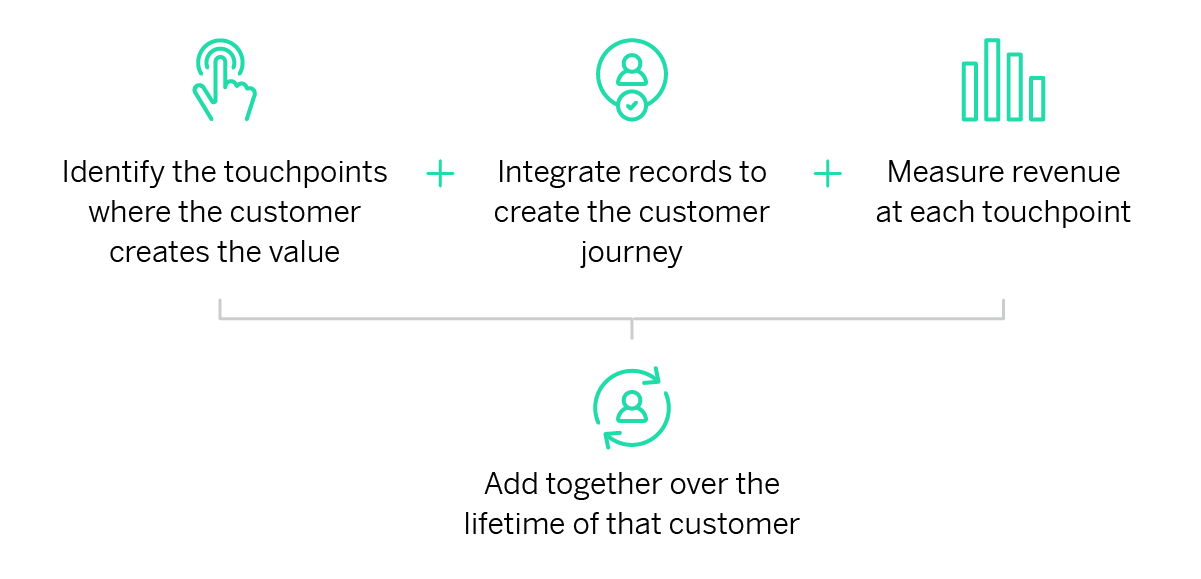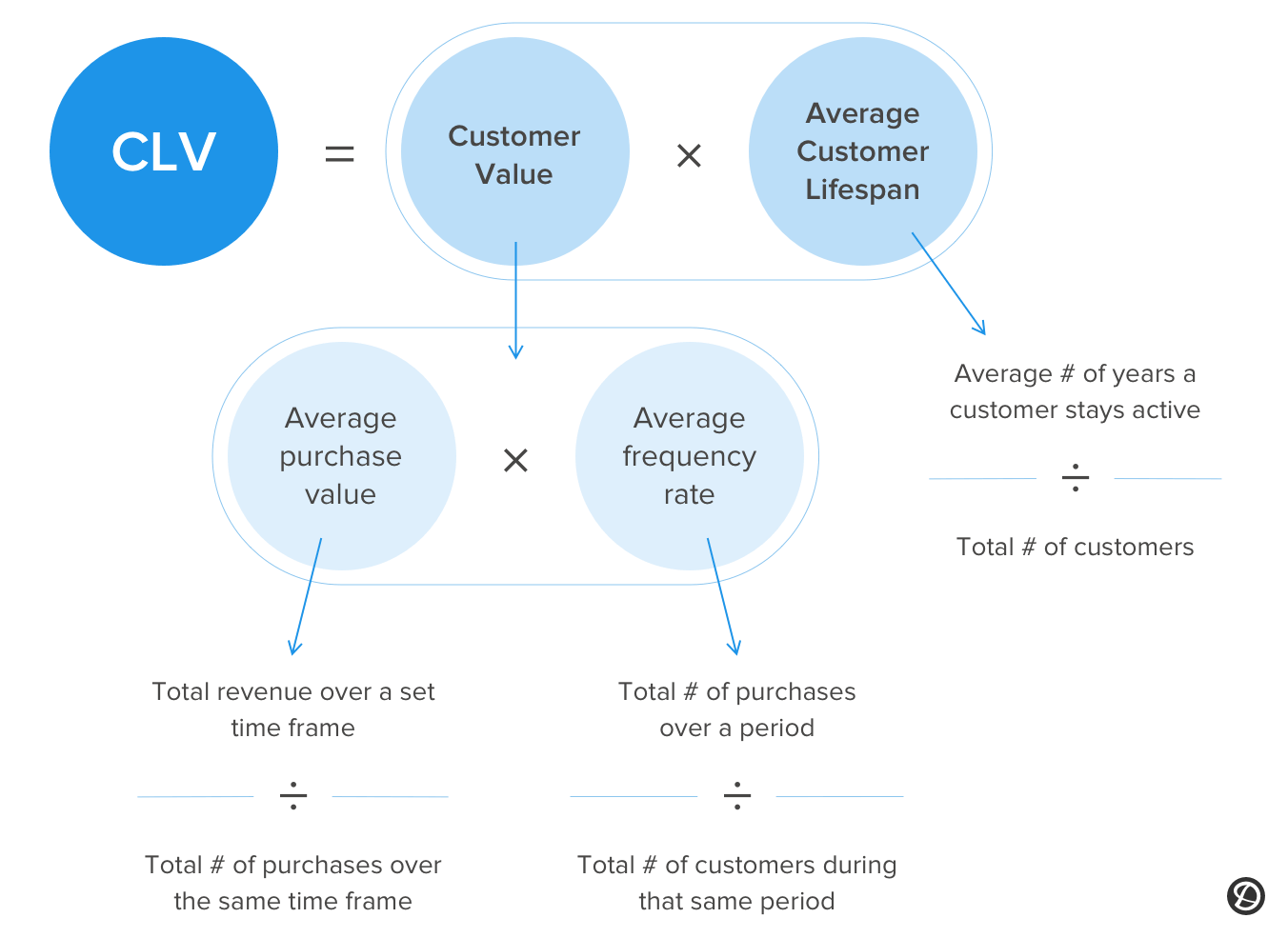How to Analyze Multi-Domain Funnel Data for Customer Lifetime Value
As businesses expand their digital presence, the importance of analyzing customer behavior across multiple domains cannot be overstated. Multi-domain funnel data provides valuable insights that enable companies to better understand their customer journey and improve customer lifetime value (CLV). In this article, we'll explore the various facets of analyzing multi-domain funnel data and how it can be used to drive business growth.
 Image source: Delighted
Image source: Delighted
Understanding Multi-Domain Funnel Data
Before we dive into the nitty-gritty of analyzing multi-domain funnel data for customer lifetime value, it's essential to understand what it is and why it matters. Multi-domain funnel data is the collection of data across various digital touchpoints that a customer interacts with before making a purchase or converting. It includes data from websites, social media platforms, mobile applications, and other online channels.
Let's take a closer look at what multi-domain funnel data entails. Say a customer is interested in purchasing a new laptop. They might start by browsing for laptops on a search engine like Google. They might then click on a link to a laptop manufacturer's website to learn more about the product. After that, they might visit the manufacturer's social media pages to see what other customers are saying about the product. Finally, they might download the manufacturer's mobile application to compare prices and make their purchase.
In this example, the customer has interacted with four different digital touchpoints: the search engine, the laptop manufacturer's website, their social media pages, and their mobile application. Multi-domain funnel data would collect and analyze data from each of these touchpoints to gain a comprehensive understanding of the customer's journey to conversion.
What is Multi-Domain Funnel Data?
Multi-domain funnel data is a collection of customer interactions with various online touchpoints before their purchase or conversion. These touchpoints include websites, social media platforms, mobile applications, and other online channels. By analyzing this data, organizations can gain valuable insights into customer behavior across domains and channels.
For example, a customer might browse a clothing retailer's website, follow them on social media, receive promotional emails, and make their purchase in-store. Multi-domain funnel data would collect and analyze data from each of these touchpoints to gain a comprehensive understanding of the customer's journey to conversion.
Multi-domain funnel data can provide organizations with a wealth of information, including:
- Which touchpoints are most effective in driving conversions
- Which touchpoints are most effective in retaining customers
- Which touchpoints are most effective in upselling or cross-selling
- Which touchpoints are most effective in generating brand awareness
Importance of Multi-Domain Data in Customer Analysis
More than ever, customers have a myriad of choices when it comes to purchasing products or services. Understanding how they interact with your brand and what triggers them to make a purchase is critical for business success. By analyzing multi-domain data, companies can identify customer preferences and pain points, allowing them to optimize their marketing strategies for higher ROI.
For example, if a clothing retailer finds that their customers are most likely to make a purchase after receiving a promotional email, they might focus their marketing efforts on email campaigns. Alternatively, if they find that their customers are most likely to make a purchase after browsing their website, they might focus on improving their website's user experience.
Ultimately, multi-domain funnel data can help organizations make data-driven decisions that lead to increased customer satisfaction, loyalty, and revenue.

Image source: Qualtrics
Key Metrics for Customer Lifetime Value Analysis
When analyzing multi-domain funnel data, certain metrics play a crucial role in determining customer lifetime value. These metrics include:
Average Revenue per User (ARPU)
ARPU is the average amount of revenue generated by each customer during a specific period. It helps businesses determine the effectiveness of their marketing campaigns and pricing strategies.
For example, if a business has an ARPU of $50 and 100 customers, their total revenue for that period would be $5,000. By analyzing the ARPU, businesses can determine if they need to increase their prices, adjust their marketing campaigns, or focus on acquiring more high-value customers.
Customer Acquisition Cost (CAC)
CAC is the amount of money spent on acquiring customers. By determining the cost of acquiring a customer, businesses can optimize their marketing spend to maximize ROI.
For instance, if a business spends $500 on marketing and acquires 10 customers, their CAC would be $50 per customer. By analyzing the CAC, businesses can determine if they need to adjust their marketing channels or reduce their marketing spend to acquire customers more efficiently.
Customer Retention Rate (CRR)
The CRR measures the percentage of customers who return to make purchases. A high CRR indicates that customers are satisfied with the product or service, leading to higher customer lifetime value.
For example, if a business has 100 customers and 80 of them return to make purchases, their CRR would be 80%. By analyzing the CRR, businesses can determine if they need to improve their product or service quality, customer support, or loyalty programs to retain more customers.
Customer Churn Rate
The churn rate measures the percentage of customers who stop doing business with the company. A high churn rate can indicate customer dissatisfaction or issues with the product or service.
For instance, if a business has 100 customers and 20 of them stop doing business with the company, their churn rate would be 20%. By analyzing the churn rate, businesses can determine if they need to improve their product or service quality, customer support, or address any issues that may be causing customers to leave.
Overall, analyzing these key metrics can help businesses optimize their customer lifetime value and improve their bottom line.
 Image source: Delighted
Image source: Delighted
Data Collection and Integration
Collecting and integrating multi-domain funnel data presents unique challenges for businesses. However, by identifying relevant data sources and using data integration techniques, organizations can collect and analyze accurate and consistent data.
Identifying Relevant Data Sources
Identifying relevant data sources is the first step in collecting multi-domain funnel data. Data sources may include Flowpoint, Google Analytics, social media platforms, CRM systems, email marketing software, and others. It is important to identify all relevant data sources to ensure a comprehensive understanding of the customer journey.
For example, social media platforms such as Facebook and Twitter can provide valuable insights into customer behavior and preferences. CRM systems can provide information on customer interactions with sales representatives and customer service agents. Email marketing software can provide data on email open rates, click-through rates, and conversions.
Data Integration Techniques
Data integration techniques vary depending on the data source. However, using APIs, data pipelines, and other technologies can help businesses integrate data across various platforms for analysis.
APIs, or application programming interfaces, allow different software applications to communicate with each other. For example, a business can use an API to integrate data from their CRM system with their email marketing software. This integration can provide a comprehensive view of customer interactions across multiple touchpoints.
Data pipelines are another data integration technique that can be used to bring data from multiple sources into a single location for analysis. Data pipelines can automate the process of collecting and integrating data, which can save time and reduce the risk of errors.
Ensuring Data Quality and Consistency
Data quality and consistency are paramount when analyzing multi-domain funnel data. Businesses must ensure that data is accurate and consistent across all touchpoints to make informed decisions.
Data quality can be affected by a variety of factors, including data entry errors, system failures, and incomplete data. To ensure data quality, businesses can implement data validation processes and data cleansing techniques. Data validation processes can help identify and correct errors in data, while data cleansing techniques can remove duplicate or incomplete data.
Data consistency is also important when analyzing multi-domain funnel data. Inconsistent data can lead to inaccurate conclusions and poor decision-making. To ensure data consistency, businesses can establish data governance policies and procedures. Data governance policies can ensure that data is standardized and consistent across all touchpoints.
In conclusion, collecting and integrating multi-domain funnel data can provide valuable insights into customer behavior and preferences. By identifying relevant data sources, using data integration techniques, and ensuring data quality and consistency, businesses can make informed decisions and improve the customer experience.
Analyzing the Customer Journey Across Domains
The customer journey across multiple domains is complex, and businesses must map the journey to understand customer behavior. This involves identifying key touchpoints, mapping the conversion funnel, and attributing revenue to the various channels.
Understanding the customer journey is crucial for businesses to improve their marketing strategies and increase conversions. By analyzing the journey, businesses can identify pain points and areas of improvement to create a seamless experience for their customers.
Mapping the Multi-Domain Customer Journey
Mapping the multi-domain customer journey involves identifying touchpoints where customers interact with the brand. These touchpoints may include search engines, social media platforms, email marketing, and others.
For example, a customer may first discover a brand through a social media post, then visit the brand's website through a search engine, and finally make a purchase through an email marketing campaign. By mapping these touchpoints, businesses can gain a better understanding of the customer journey and optimize their marketing efforts accordingly.
Identifying Key Touchpoints and Conversions
Identifying key touchpoints and conversions is essential to understanding customer behavior. It helps businesses determine which channels are driving conversions, allowing them to optimize their marketing strategies for higher ROI.
For instance, if a business finds that a majority of their conversions come from social media platforms, they may choose to allocate more resources towards social media marketing to increase their ROI.
Attribution Modeling for Multi-Domain Analysis
Attribution modeling involves assigning credit to different touchpoints for a conversion. This allows businesses to understand the effectiveness of each channel and make data-driven decisions regarding their marketing strategies.
For example, a customer may first discover a brand through a search engine, then visit the brand's website through a social media post, and finally make a purchase through an email marketing campaign. By using attribution modeling, businesses can assign credit to each touchpoint and determine the most effective channels for driving conversions.
In conclusion, analyzing the customer journey across multiple domains is crucial for businesses to understand customer behavior and optimize their marketing strategies. By mapping the journey, identifying key touchpoints and conversions, and using attribution modeling, businesses can create a seamless experience for their customers and increase their ROI.
Conclusion
Multi-domain funnel data provides invaluable insights into customer behavior, allowing businesses to optimize their marketing strategies and drive growth. By understanding key metrics, collecting and integrating data, and mapping the customer journey, businesses can gain a deeper understanding of their customers and make informed decisions.
At Flowpoint, we offer powerful multi-domain funnel tracking capabilities to help businesses gain valuable insights into customer behavior and optimize their marketing strategies for growth. Register for Flowpoint's multi-domain funnel tracking today.
Contact
FLOWPOINT ANALYTICS LTD
Company Number 14068900
83-86 Prince Albert Road, London, UK
© 2024. All rights reserved @Flowpoint